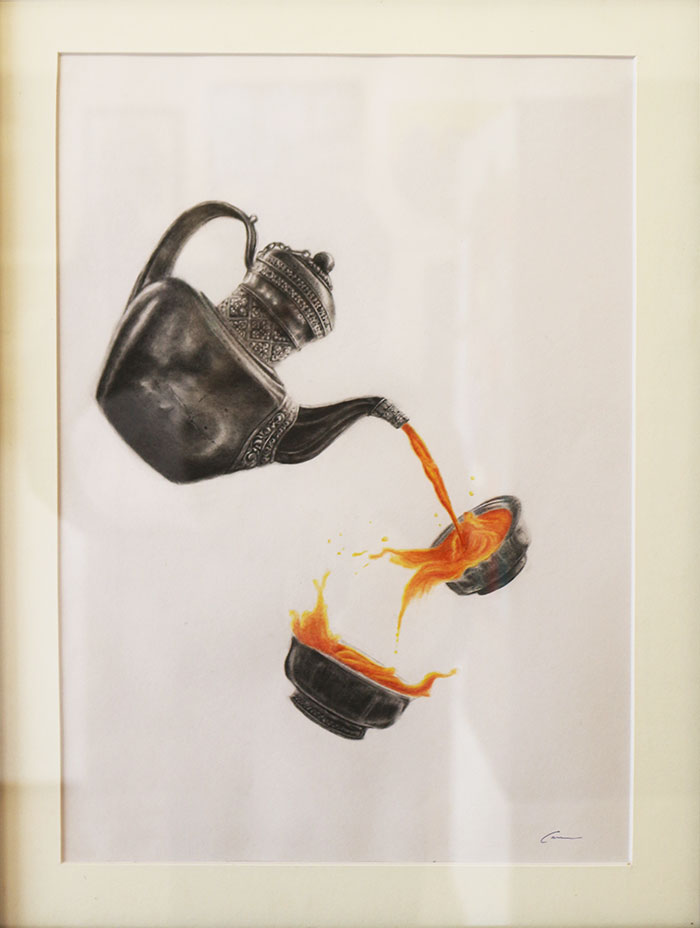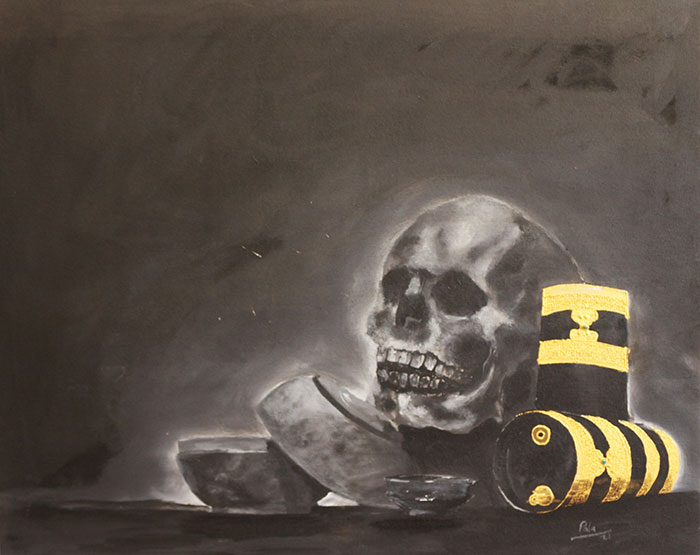
The artworks were created using acrylic paint, pencil, pen, fabric colour, oil and charcoal.
Chhimi Dema
From an ornate teapot (Jamjee) spurts fiery orange tea and cascades down into two cups (Phorp). Orange, the colour of joy, warmth, health and happiness is intentional. This is ‘Tea with a bit of Happiness’ by Lhaksam Tempey Gyeltshen.
The artwork is being displayed at the Still Life exhibition in the Bhutan Art Gallery in Thimphu among 58 other artworks.
Lhaksam, a self-taught artist, said that the artwork portrays the serene tea hour with his family during the second nationwide lockdown. “We were getting anxious, confined at home. So, we gathered to share our thoughts. That moment was blissful.”
Lhaksam said that platform like the exhibition was important to share stories and to connect with people.
The exhibition is being organised by VAST Bhutan with support from the Royal Textile Academy of Bhutan.
The artworks at the gallery were submissions from the Modern Art Competition organised by VAST Bhutan. The theme for this year’s Modern Art Competition was Still Life.


Not only limited to Still Life-the form of painting inanimate objects, the artworks reflected thoughts, moods, and emotions experienced when life stood still during the lockdown.
VAST Bhutan’s executive director, Chimi Zangmo, said that the theme ‘Still Life’ resonated with the unprecedented times people are experiencing today.

“By organising events like these, we sincerely hope to invoke curiosity, courage, contemplation and compassion,” Chimi Zangmo said. “It is really about finding ourselves, the artists in us.”
She said that visuals are a powerful medium to connect with others. “But more profoundly to connect with oneself.”
When an artist is observant or mindful and deeply passionate about his or her art form, the creations can deeply move others and that is what humanity is, even if it is for a fraction of a second in one’s life, she added.
The exhibition will close next month.

Art is ever-changing, moving with the rhythm of time and minds. Appreciating art opens the mind. As different perspectives are shared about art, it brings thoughtful dialogues triggering one’s understanding that there is more than one approach to everything.
Sukbir Bishwa, an artist, said: “There isn’t any need to practice or become well educated to appreciate art. Life is connected to art in ways more than one.”
He said that art appreciation meant judging, criticising and analysing the many art forms.
“Right at the beginning of my journey as an artist, people criticised bluntly that my paintings were flat. My paintings were flat because I had not learned how to utilise the effect of light in a painting to create dimension,” he said. “Whoever criticised me helped me improve.”
Art appreciation, he said, was important for the growth of anyone who is involved in artistic endeavours.
Tintin Pem Tshering, an artist, said that art appreciation was always there in the Bhutanese society, only art had a completely different purpose and meaning.
“To change the mindset of our society to see art differently will take some time,” he added.
Tintin Pem Tshering said that when an artist communicates through their work and people react to it, the artist grows. “You need people to view and engage with your art.”
Another artist, Passang Dema, said that to appreciate modern art the best way is to engage in the art itself.
It can be as simple as sitting down and drawing a line, she said. “In that moment, you will be able to understand either how fun the process is or how much time the artist takes to create an artwork.”

